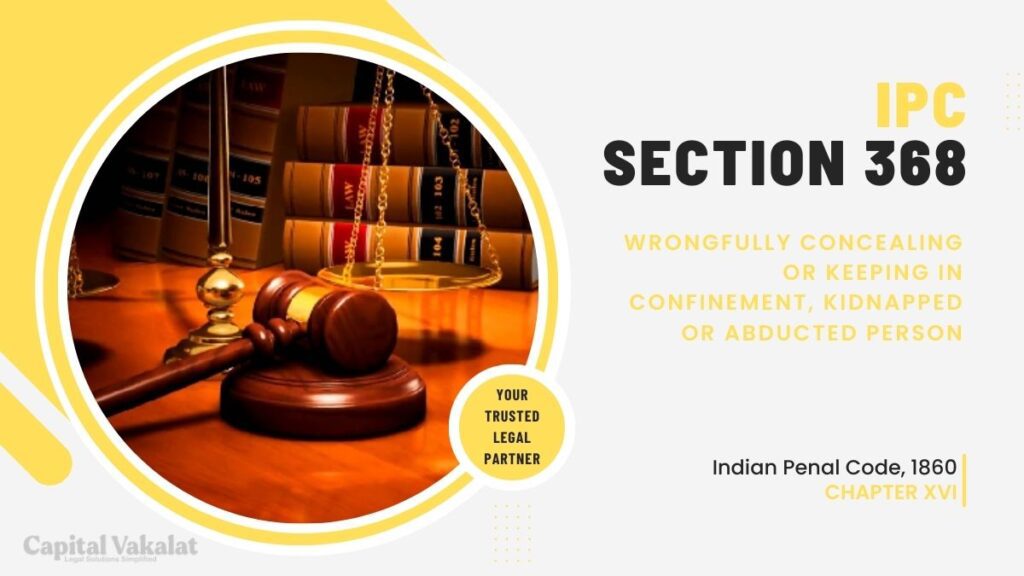In the realm of legal provisions, Section 368 of the Indian Penal Code (IPC) holds paramount significance as it pertains to the wrongfully concealing or keeping in confinement, kidnapped, or abducted persons. The essence of this section lies in safeguarding individuals from acts that threaten their freedom and well-being.

This article delves into the intricacies of Section 368 IPC, shedding light on its elements, legal consequences, and the broader implications of wrongful confinement.
Understanding Section 368 IPC
At its core, Section 368 IPC addresses the grave offense of wrongfully concealing or keeping in confinement any person against their will. The section encompasses a wide range of scenarios, from abduction to wrongful confinement, and serves as a crucial legal instrument in upholding individual liberties. Offenders may face severe legal consequences, making it imperative to comprehend the nuances of this provision.
Kidnapping vs. Abduction
It is essential to distinguish between kidnapping and abduction, as both terms are often used interchangeably but carry distinct legal implications. Kidnapping involves the unlawful transportation of a person against their will, while abduction refers to the act of taking someone away by force or threat. Understanding these differences is crucial in the context of Section 368 IPC, as the legal repercussions for each act may vary.
Signs and Indicators of Wrongful Confinement
Identifying signs of wrongful confinement is pivotal in preventing and addressing such cases. Victims may display behavioral changes, such as increased anxiety or withdrawal. Additionally, physical evidence, such as signs of struggle or restricted movement, can serve as crucial clues for intervention. Recognizing these indicators empowers individuals and communities to act promptly in the face of potential wrongdoing.
Reporting and Legal Procedures
In the unfortunate event of someone being wrongfully confined or abducted, swift and informed action is imperative. Reporting such incidents to law enforcement initiates legal procedures that aim to rescue the victim and bring the offenders to justice. Understanding the steps involved and cooperating with legal authorities enhances the effectiveness of the response to these grave offenses.
Recent Cases and Legal Precedents
Examining recent cases related to Section 368 IPC provides insights into the application of the law and its outcomes. Notable judicial decisions set legal precedents, shaping the interpretation and implementation of the section. Analyzing these cases not only informs the public but also serves as a deterrent for potential offenders.
Preventive Measures and Awareness
Preventing wrongful confinement requires a proactive approach that involves educating the public on personal safety. Community involvement plays a crucial role in fostering a sense of responsibility towards the well-being of others. By promoting awareness and vigilance, communities can contribute to creating a safer environment for everyone.
Impact on Victims
The consequences of wrongful confinement extend beyond the physical act, leaving lasting psychological and emotional scars on victims. Understanding the profound impact on individuals is essential in developing comprehensive support and rehabilitation programs. Acknowledging the trauma victims endure emphasizes the need for a compassionate and empathetic response.
Public Awareness Campaigns
Media and non-governmental organizations (NGOs) play a pivotal role in disseminating information and fostering public awareness. Collaborative efforts in organizing awareness campaigns can significantly contribute to preventing wrongful confinement. By leveraging various platforms, these campaigns aim to educate the public, dispel myths, and encourage a collective commitment to ensuring the safety of every individual.
Conclusion
In conclusion, Section 368 IPC stands as a formidable deterrent against the wrongful concealing or keeping in confinement, kidnapping, or abduction of individuals. The multifaceted nature of this legal provision underscores the need for a comprehensive understanding of its elements and implications. By promoting awareness, encouraging community involvement, and understanding the profound impact on victims, society can work collaboratively to create a safer and more vigilant environment.
Frequently Asked Questions
What steps should one take if they suspect someone is wrongfully confined?
Immediately report the suspicion to local law enforcement and provide any relevant information to aid in the investigation.
Are there specific preventive measures individuals can take to avoid wrongful confinement?
Being vigilant, staying informed about personal safety, and actively participating in community awareness initiatives are effective preventive measures.
How does the legal system address cases of wrongful confinement under Section 368 IPC?
The legal system follows a comprehensive procedure, involving investigation, rescue of the victim, and legal proceedings against the offenders.
What role do public awareness campaigns play in preventing wrongful confinement?
Public awareness campaigns contribute to educating the community, dispelling myths, and fostering a collective commitment to ensuring the safety of individuals.